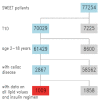The Association between Treatment Modality, Lipid Profile, Metabolic Control in Children with Type 1 Diabetes and Celiac Disease-Data from the International Sweet Registry
- PMID: 34960025
- PMCID: PMC8707296
- DOI: 10.3390/nu13124473
The Association between Treatment Modality, Lipid Profile, Metabolic Control in Children with Type 1 Diabetes and Celiac Disease-Data from the International Sweet Registry
Abstract
Background and aims: A higher frequency of dyslipidemia is reported in children with type 1 diabetes (T1D) and celiac disease (CD). Recently, continuous subcutaneous insulin infusion (CSII) has been associated with better lipid profiles in patients with T1D. The aim of this study was to investigate the association between treatment modality and lipid profile, metabolic control, and body mass index (BMI)-SDS in children with both T1D and CD.
Methods: Cross-sectional study in children registered in the international SWEET database in November 2020. Inclusion criteria were children (2-18 years) with T1D and CD with available data on treatment modality (CSII and injections therapy, IT), triglyceride, total cholesterol, HDL, LDL, dyslipidemia, HbA1c, and BMI-SDS. Overweight/obesity was defined as > +1 BMI-SDS for age. Data were analyzed by linear and logistical regression models with adjustment for age, gender, and diabetes duration.
Results: In total 1009 children with T1D and CD (female 54%, CSII 54%, age 13.9 years ±3.6, diabetes duration 7.2 years ±4.1, HbA1c 7.9% ±1.4) were included. Significant differences between children treated with CSII vs. IT were respectively found; HDL 60.0 mg/dL vs. 57.8 mg/dL, LDL 89.4 mg/dL vs. 94.2 mg/dL, HbA1c 7.7 vs. 8.1%, BMI-SDS 0.4 vs. 0.6, overweight and obesity 17% vs. 26% (all p < 0.05).
Conclusions: CSII is associated with higher HDL and lower LDL, HbA1c, BMI-SDS, and percentage of overweight and obesity compared with IT in this study. Further prospective studies are required to determine whether CSII improves lipid profile, metabolic control and normalize body weight in children with both T1D and CD.
Keywords: celiac disease; continuous subcutaneous insulin infusion; glycemic control; lipid profile; type 1 diabetes.
Conflict of interest statement
The authors declare no conflict of interest.
Figures
Similar articles
-
Proportion of Basal to Total Insulin Dose Is Associated with Metabolic Control, Body Mass Index, and Treatment Modality in Children with Type 1 Diabetes-A Cross-Sectional Study with Data from the International SWEET Registry.J Pediatr. 2019 Dec;215:216-222.e1. doi: 10.1016/j.jpeds.2019.06.002. Epub 2019 Jul 22. J Pediatr. 2019. PMID: 31345576
-
Association of the use of diabetes technology with HbA1c and BMI-SDS in an international cohort of children and adolescents with type 1 diabetes: The SWEET project experience.Pediatr Diabetes. 2021 Dec;22(8):1120-1128. doi: 10.1111/pedi.13274. Epub 2021 Nov 9. Pediatr Diabetes. 2021. PMID: 34716736
-
Celiac disease in children with type 1 diabetes varies around the world: An international, cross-sectional study of 57 375 patients from the SWEET registry.J Diabetes. 2021 Jun;13(6):448-457. doi: 10.1111/1753-0407.13126. Epub 2020 Nov 30. J Diabetes. 2021. PMID: 33118261
-
Effectiveness of Continuous Subcutaneous Insulin Infusion on Parental Quality of Life and Glycemic Control Among Children With T1D: Meta-Analysis.Worldviews Evid Based Nurs. 2018 Oct;15(5):394-400. doi: 10.1111/wvn.12312. Epub 2018 Jul 22. Worldviews Evid Based Nurs. 2018. PMID: 30033649 Review.
-
Diabetes technology and treatments in the paediatric age group.Int J Clin Pract Suppl. 2011 Feb;(170):76-82. doi: 10.1111/j.1742-1241.2010.02582.x. Int J Clin Pract Suppl. 2011. PMID: 21323816 Review.
Cited by
-
Influence of ultra-processed food in the diet of South Indian young adults: an explanatory mixed method study.Eur J Nutr. 2024 Sep;63(6):2339-2355. doi: 10.1007/s00394-024-03429-4. Epub 2024 May 25. Eur J Nutr. 2024. PMID: 38795126
-
A Risk Profile for Disordered Eating Behaviors in Adolescents with Type 1 Diabetes: A Latent Class Analysis Study.Nutrients. 2023 Mar 31;15(7):1721. doi: 10.3390/nu15071721. Nutrients. 2023. PMID: 37049563 Free PMC article.
-
Specific signaling pathways mediated programmed cell death in tumor microenvironment and target therapies.Discov Oncol. 2025 May 16;16(1):776. doi: 10.1007/s12672-025-02592-2. Discov Oncol. 2025. PMID: 40377777 Free PMC article. Review.
References
-
- Mahmud F.H., De Melo E.N., Noordin K., Assor E., Sahota K., Davies-Shaw J., Cutz E., Somers G., Lawson M., Mack D.R., et al. The Celiac Disease and Diabetes-Dietary Intervention and Evaluation Trial (CD-DIET) protocol: A randomised controlled study to evaluate treatment of asymptomatic coeliac disease in type 1 diabetes. BMJ Open. 2015;5:e008097. doi: 10.1136/bmjopen-2015-008097. - DOI - PMC - PubMed
-
- Mahmud F.H., Murray J.A., Kudva Y.C., Zinsmeister A.R., Dierkhising R.A., Lahr B.D., Dyck P.J., Kyle R.A., El-Youssef M., Burgart L.J., et al. Celiac Disease in Type 1 Diabetes Mellitus in a North American Community: Prevalence, Serologic Screening, and Clinical Features. Mayo Clin. Proc. 2005;80:1429–1434. doi: 10.4065/80.11.1429. - DOI - PMC - PubMed
MeSH terms
Substances
LinkOut - more resources
Full Text Sources
Medical


